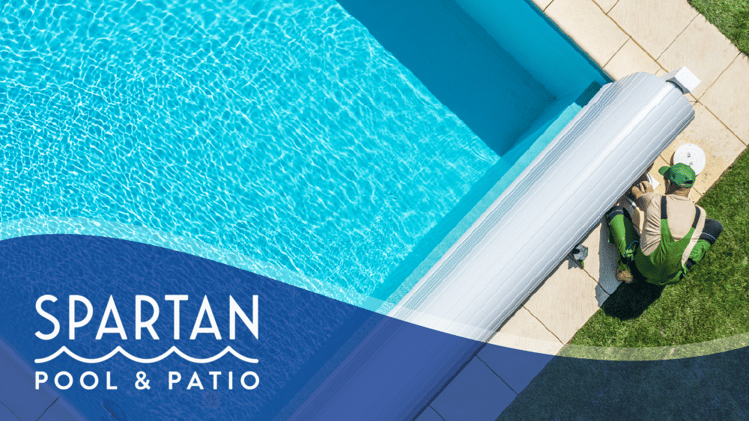
No one wants to dive into murky, cloudy— or worse, slimy—pool water. If you want to keep your pool clear, crisp, and inviting, you’ll need to familiarize yourself with a little chemistry, as well as keep up with repairs and maintenance regularly.
Let’s dive into some of the reasons your pool water may be cloudy, how to clear it up, and prevent it from happening again.
#1 Improper Levels of Chlorine
If you own a pool, you most likely already know that chlorine is an important part of keeping the water crystal clear and free of germs.
How Does it Work?
Adding chlorine to your pool water creates an acid called hypochlorous acid that, while mild, is effective in killing off harmful germs.
There are a number of chlorine-based compounds available on the market including gas, sodium hypochlorite (also known as liquid bleach), calcium hypochlorite, lithium hypochlorite, and chlorinated isocyanurates. Using these chemicals is sometimes referred to as “shocking” the pool.
Adding chlorine to your pool not only protects you from contaminants like salmonella, E. coli, and viruses that cause things like diarrhea and ‘swimmer’s ear’—it also helps keep the water clear.
(Pro-tip: a well-managed, healthy pool should never smell like chemicals.)
#2 Imbalanced pH and Alkalinity
Total alkalinity (or TA) measures your pool water’s capacity to resist fluctuations in the pH. Total alkalinity helps act as a sort of buffer that keeps levels at an even keel.
Your pool’s pH refers to how acidic or alkaline your pool water is.
High levels of pH can cause calcium to build up, making the pool water look cloudy. However, you need to achieve a balance, as low levels of pH can cause chlorine to become highly reactive and subsequently depleted, leading to cloudy water.
You should target a level of pH between 7 and 7.6. A 7 pH means the pool water is neutral, while anything below 7 indicates acidity, and anything higher than an 8 can cause unpleasant side effects like skin rashes andirritate swimmers’ eyes. You want to hit that sweet spot right in the middle.
#3 Very High Calcium Hardness (CH) Levels
Calcium hardness or “CH” is a term used to measure the amount of mineral calcium present in your pool water. You may have seen or felt a slippery layer or scale on pool surfaces and equipment, and that’s because the CH is too high.
As with pH, you want to hit a certain target to maximize effectiveness and reduce damage to your pool. Depending on whether you have vinyl or fiberglass liner, you’ll want to keep CH levels between 175 and 225 parts per million (ppm) as appropriate.
To return CH to healthy pool levels, try the following:
- Drain and replace some water (this step may seem obvious but is commonly overlooked)
- Use a pool flocculant to help clump the calcium so it’s easier to vacuum up.
- Use muriatic acid. This should be a last resort because while it will raise saturation levels to clear up any cloudiness, it doesn’t actually reduce the water’s CH.
#4 A Faulty or Clogged Filter
Inspect your filter system. Worn out or broken parts can contribute to a murky, cloudy pool.
Ideally, you should run the pump for at least eight hours every day. (Most pumps complete the cycle in 8-12 hours so keep an eye out to see if you need to leave the pump running for a little longer than eight hours.)
A healthy pool should make a complete water circulation (or “turnover”) at least once every 24 hours.
#5 Early Stages of Algae
These single-celled organisms can wreak havoc on your pool and can turn your pool water cloudy or green, sometimes within a matter of hours.
Once again, chlorine comes to the rescue! It’s a good idea to consult with a pool specialist if you suspect algae growth because you may need help achieving the perfect balance between the pH and CH in your pool.
#6 Ammonia
Ammonia is a result of bacteria that run rampant when your pool isn’t frequently sanitized, especially if you’ve been lax on taking the right steps to open and close your pool every season.
To clear ammonia, you’ll need a lot of chlorine– about two gallons of between 12.5% and 10% chlorine. The goal is to reach high free chlorine shock levels and keep them high by adding chlorine any time the FC drops.
(FC refers to “free chlorine,” the level of disinfecting chlorine that’s available to maintain sanitization.)
#7 Debris
Keep a watchful eye for any debris that winds up near or around your pool filter. Using a pool brush to sweep away detritus regularly saves a lot of headaches later.
If you don’t already have one, consider buying a pool vacuum. While vacuuming your pool requires some effort, it’s an extremely effective way to fight algae and keep your pool water balanced.
Need Help?
Achieving the right chemical balances in your pool can seem daunting, so don’t be shy about calling in the experts. At Spartan Pool & Patio, we help you achieve worry-free pool ownership by keeping your pool water clean and cloud-free. Give us a call today to find out how we can help you experience all the joy of pool ownership!

